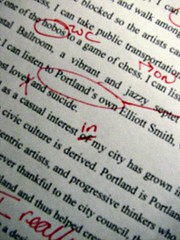There are probably as many ways to edit a story as there are to write one. Today, I’m thinking about “macro” edits—looking at structure and scene placement, rather than the individual words and style.
One of my favorites has been the scene chart, inspired by a post on Edittorrent. The original post suggested creating index cards for each scene, listing a  number of important features—everything from where and when the scene is set, to first and last lines, to “promises” made to the reader, to important details like descriptions. Then you could move the index cards around to resequence events or scenes, or play with the story without hurting your MS.
number of important features—everything from where and when the scene is set, to first and last lines, to “promises” made to the reader, to important details like descriptions. Then you could move the index cards around to resequence events or scenes, or play with the story without hurting your MS.
Like many of the commentators on the post, however, I used a spreadsheet to do this in a very small space. I also combined this with probably the most important thing I learned from Jack Bickham’s Scene & Structure—the structure of a scene and the importance of a scene goal—for the character, not just me as a writer.
When I used these techniques together, I found that the scenes that lacked a goal for the character (or a unique goal, as opposed to one that the character’s had four times now) were often the unfocused scenes I needed the most work on—or to cut altogether. I could also bring out hidden scene goals, find new ones to add layers to a scene and strengthen the scenes by enhancing the goals, conflict and disasters.
So here’s an example of the kind of scene chart I used, partially filled in for an imaginary story (anybody recognize the plot? Hint: it’s from an old card game). I didn’t use all of these columns myself (and if any of them aren’t clear, feel free to ask what I mean).
That’s just one thing I’ve tried, and I liked it so well, I’ll definitely use it in the future.
What do you think? Do you use a form of scene charts? What’s your favorite “macro” editing technique?
Photo credit: Aaron Brown


What a great idea, Jordan. I haven’t used anything like that, but I’ll try it.
I just went over to Eddittorrent and checked out that post. Fantastic! I will definitely use a scene chart from now on. I’ll be able to cut the time it takes to finish a manuscript now, instead of going back through and looking for things, like times and dates where things have happened. Also it saves repetition of action and body language as well as repeated dialogue.
Thanks so much for such a great post, Jordan. I have left one over there too, but it has to be checked by the moderator first.
I’m working with cards right now, but now that I think about it, I’m missing a few things on the cards.
Sigh. That probably means I’ll have to do another pass through them.
Missing that “goal” and “disaster” section.
Will check out those links!
This is a great system. I’ve never done anything like it.
Btw, I took the MFA/writer question to the SCBWI conference I attended last week. I asked Sydney Salter (J/YA author of 3 published books) her opinion of an aspiring writer going for an MFA. She said pretty much this, “Why? Do you want to be a professor?” And I said, “No, I want to write. I want to learn to become a better writer.” And she replied, “Well, then, write!”
Needless to say, I feel as if I’ve arrived at my answer.
I created a chart based on Larry Brooks book, but I’m a rookie at this. Is there any way to send it to you for your review and suggestions? I’ve been passing it out when queries come in and asking authors to return it with their manuscripts. I’ve just had one person do it, so I’m not sure if it is working or not.
I would love to be able to get a copy of your worksheet. Pretty please?
While I use Story Structure for my plot, I make “chapter” (scene) cards after the first draft is written. I find it too restricting beforehand. Then I am able to lay them out on my table and mess with them untill I get the right order of it all. The scene charts really help me.
Jordan, Thank you for your allways informative and thoughtful posts. You do a great job here.
You do a great job here.
@Trish—Awesome! Highly recommend Edittorrent!
@Andrew—Good luck with your revisions!
@T—Thanks for the follow up!
@Mary—I can take a look at the chart, but I imagine it’s pretty hard for someone to understand unless they’ve studied Larry Brooks’s structure (and I have, so I might not be much help). On the other hand, it’s very helpful for a publisher as well as a writer to look at their own work that way.
For personal use, you can just copy and paste the chart above into a spreadsheet program. To pass out or use in a presentation, I’d appreciate it if you included the web address (URL) on the page/powerpoint slide. Thanks!
@Michelle—Well, yeah, it’s a lot harder to edit something before you’ve written it . I’ve tried to fill out my chart as I write, but it got to be too much interruption to my writing. Thanks!
. I’ve tried to fill out my chart as I write, but it got to be too much interruption to my writing. Thanks!